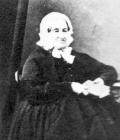1
Watercolour monotype of Frances Stewart19th Century, Circa 1840
Douro, Ontario
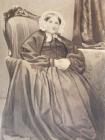 Credits:
Credits:Hutchison House Museum, Peterborough, Ontario
2
Frances Stewart and her husband were among the earliest settlers in Peterborough County. She wrote many letters to friends and family both in Ireland and Canada. Her letters, published after her death, detailed how an immigrant family adapted to the pioneer lifestyle while trying to maintain an air of gentility.Frances Stewart was born May 24, 1794, in Dublin, Ireland. She met Thomas A. Stewart in the summer of 1816 and they soon married. Thomas had a modest income, but due to hard times in Ireland decided to immigrate to Canada with his family along with his brother-in-law Robert Reid and his family. The Stewarts and their daughters sailed from Belfast to the New World on February 9, 1821.
The Stewart and Reid families stayed in Cobourg while Thomas and Robert set out to explore Douro Township at the head of the Trent River. Their cabin was built on a bank above the river. The Stewarts left Cobourg in February of 1822 to their unfinished home. In the first year Thomas built furniture for the house, cleared the land and planted crops. Until the crops came in they ate salt pork, pea soup, bread, and wild plants, and drank tea (made from hemlock tips) and coffee (derived from burnt Indian corn).
3
'Auburn' Home of Frances Stewart in Douro19th Century, Circa 1830
Douro, Ontario
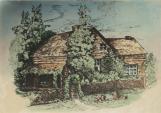 Credits:
Credits:Peterborough Museum and Archives 1978-012 (V4pg9)
4
Stewart and Reid oversaw the colonization of 10,000 acres in Douro over three years. Due to the lack of "civilization" and company in the backwoods, the Stewarts were thinking of moving to Cobourg when they heard about the Peter Robinson Immigration. With the immigration came the makings of a village in the area with shoemakers, carpenters, a mason, a baker, and plans for an Anglican Church and school.In 1826 Sir Peregrine Maitland and several guests visited the settlement. The Stewarts attended his reception at the government house. It was at this meeting that Frances suggested the name 'Peterborough' for the little village in honour of Peter Robinson.
In 1833 Thomas A. Stewart was appointed to the legislative council at York, a position he held until 1841. Stewart was active in local affairs and in many instances sat on the same committees as Dr. Hutchison such as the Peterborough General Society and the building committee for the Peterborough County Court House.
5
Frances Stewart recounting their first year in Douro19th Century, Circa 1822
Douro, Ontario
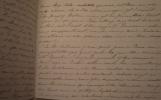 Credits:
Credits:78-008/2/14 #277
Trent University Archives, Peterborough, Ontario
6
Life in the backwoods of Canada was much harsher than back home in Europe. The area was mostly forest, neighbors were far apart, and while diseases like ague and cholera were common, there were few doctors for large areas.The first noted encounter the Stewarts had with Dr. Hutchison was in 1823 when their daughter Bessie was suffering from dysentery. Also known as flux, dysentery is an inflammatory disorder of the intestine. This results in severe diarrhea, fever and abdominal pain that can be fatal if left untreated.
Donald McIntyre, who worked for the Stewarts, traveled 18 miles from his home in Monaghan Township to fetch Dr. Hutchison. The doctor arrived 2 days later, but it was too late. Bessie had died and was buried near their cabin. Frances recounts the episode to her daughter Ellen:
"In the Autumn of our first year in Douro our youngest little girl of not quite two years old was seized with Dysentry. I was quite ignorant of the disease and there was no Doctor within reach- The nearest being Dr Hutcheson who then resided in Cavan, a good many miles distant. We had as yet no canoe on the River and were often depending on a chance visit of the Indians for a passage to the other side. One of our hired men, a faithful Highlander, seeing how very ill our darling was volunteered to swim across the rapid stream and walk through the woods to the Doctor, promising that if I wrote the particulars, he would bring the necessary medicines. He started early in the morning of a cold October day and returned about midnight with some powders, and a message that the Doctor would come up on the following day - But no improvement and the day passed in great anxiety for the Doctor did not arrive.
On the third day he came having left at the promised time, but lost his way in the woods and hence the delay. The next day she appeared more lively, but refused to take the arrowroot and says which I offered her. She asked for bread and of this we had none fit to give her, having for sometime been unable to procure good flour. It was a bitter trial not to have what she seemed to crave for."
7
Stewart entry in Dr. Hutchison's Birth Registry26 August 1830
Peterborough, Ontario
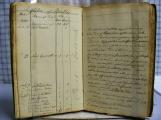 Credits:
Credits:Hutchison House Museum, Peterborough, Ontario
8
The Stewarts and Hutchisons became good friends, and the good doctor often appears in the tales and descriptions of the backwoods that Frances writes home to friends and relatives.In 1823 she describes Dr. Hutchison as:
"… There is a most skilful doctor who lives about fourteen miles off. He visits every family in the neighborhood once a fortnight, and appoints places where he can receive messages. Our names are down on his lest; every one he visits in this manner pays him three dollars a year! He is a Scotchman, young but clever."
Dr. Hutchison was close enough to the Stewarts that she felt comfortable lending him books. These were an expensive commodity to backwoods families. The collection that the Stewarts had were sent from family and friends back home in Ireland.
"The books are wonderful comfort not only to us but to many others- Mr Rubidge & Dr Hutchison have borrowed many of them-"
There was a friendly rivalry between Ellen Stewart, Frances' daughter, and Dr. Hutchison. Both planted peach stones at the same time and watched avidly to see whose would be the first and best to grow.
9
Frances Stewart letter written to Harriet Beaufort, Dublin14 December 1840
Peterborough, Ontario
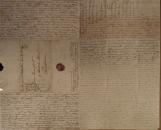 Credits:
Credits:78-008/2/10 #178
Trent University Archives, Peterborough, Ontario
10
The Stewarts were faithful subscribers to Dr. Hutchison's medical insurance and with nine children the Stewarts saw him a lot. One such episode is described by Frances in a letter to her good friend Harriet in which Edward, who was an employee and like family, was accidentally shot:To Harriet Beaufort, Dublin, Dec 14th ,1840
"…1st sleighing has begun & the roads are in tolerable order now & 2nd many friends have called to enquire about poor Edward- who lately met with an accident which alarmed us greatly & might have been very serious, but most providently has turned out not so bad- A gun went off accidently and wounded him-in his shoulder- he bled most profusely- indeed frightfully- so that he was as I thought lifeless when brought home- & for some hours we feared he never could live- but miraculously the Dr. says, no vital part was touched- tho' the space was inconceivably small between the wound & a great artery on one side & a muscle on the other which was only grazed but which would have injured the use of his arm- tho still wan & weak & suffering a good deal of pain- but we all have reason to feel thankful that the life of our poor excellent friend has been spared"
Another common event was recorded Frances in June, 1843 when her daughter Ellen, who suffered from 'Low Spirits,' or Melancholia, stays with the Hutchisons for treatment:
"Ellen will stay with Mrs H to be once more under the care of our dear, good doctor…he cured her twice before."
11
Stewart entry in Dr. Hutchison's Patient Ledger19th Century, Circa 1830
Peterborough, Ontario
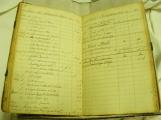 Credits:
Credits:Hutchison House Museum, Peterborough, Ontario
12
Hutchison also vaccinated the Stewart children. It is believed that only the upper class had their children vaccinated because of the cost involved. It is thought that Dr. Hutchison was vaccinating for small pox, however Frances never says exactly what it was for.Feb 1824
"…she was vaccinated on Sunday when our little Dr paid us a visit- he improves on acquaintance very much & we like him better every time we see him."
Cholera outbreaks were common in Upper Canada during the 19th century and several serious outbreaks of cholera occurred in the Peterborough area including one in the 1820s, another in the 1830s, and several in the 1840s.
Frances writes about her worry of an outbreak, but is confident in Dr. Hutchison's skills should one occur:
"As to the cholera, I have scarcely any fears about it for my friends, and if it comes here it will then be time enough and we have the blessing of an excellent physician in Dr Hutcheson He says some years ago he had several cases under his care in this district of the real Eastern cholera but it did not spread-"
14
Thomas A. Stewart encouraged the development of the Trent Canal, worked on its building committee, raised money for the Irish famine, and was a trustee for St. Johns Church , Armour School, and the grammar school. In 1837 he drilled a small company of soldiers in preparation for the rebellion. During the summer of 1847 Thomas A. Stewart was one of the volunteers at Hospital Point along with Dr. Hutchison, caring for the sick Irish immigrants. Sadly, he became one of the casualties. Today in Peterborough there is a high school named for him, in honour of all his work for the early schools in Peterborough as well as his other achievements around town.Frances Stewart became known through the publication of many of her letters that she had written to family and friends. During a trip home to Ireland in 1853, Stewart's granddaughter, Ellen Dunlop, brought home many of these letters. Ellen eventually compiled these letters into a book and publish them as 'Our Forest Home', giving us one of the earliest accounts of life in Peterborough and great insights into the trials of life in the backwoods of Upper Canada from the perspective of a middle-class Irish woman.
